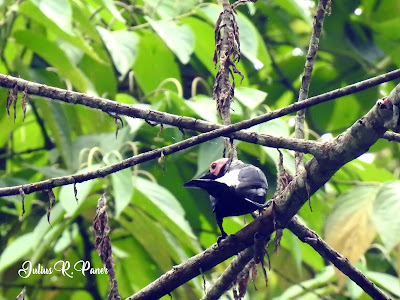The last few days I was busy doing "toxic" stuff, all work-related and most of which are
office-based like meetings, client conversations and invitations from other
national agencies. But on November 6 and 7 I cancelled all my schedules to
attend to a very important invitation from Barangay Captain Mercedita
Rivera of Sinoron to explore two waterfalls in two of its remote sitios. This is
part of the barangay’s effort to be considered to become one of the tourism
attractions in Sta. Cruz.
Sinoron
is always referred to as a mountainous barangay of Sta. Cruz with almost all
its sitios situated in a forested area, majority of which belonging to the Mt.
Apo Natural Park. The Pilan River serves as its main divisor which almost
equally cut-half the nineteen sitios. Sitio Pilan is the most common identity
as the starting point of the forest sites. Going right from Pilan Hanging
Bridge are more populated sitios Lumaban, Bagon, Egpit, Sangay, Pula Pulahan,
Sampo, Viga and Libodon while to the left side are farmland sitios Limalima,
Dulian, Landig, Gisi, Caramagan, Dumagok, Licop and Saroso.
Our
trek started in Barangay Hall following a short conversation with Barangay
Captain Rivera. After an hour we reached Pilan River Hanging Bridge where I was
supposed to hire a porter from the community so that I could focus on taking
pictures along the trail. Unfortunately no one was available so I just carried
on with my backpack as we got to our first target destination Lumaban Water
Basin. This spring is the main source of potable water in Sinoron and even in
adjacent barangay Zone II. This is also a very good site to cool down with its
variety of open pools and water droplets coming out from the vertical rock
wall. As we head back to the hanging bridge and proceeded to our pit stop in
sitio Caramagan I realized that Sinoron is the “Water World” of Sta. Cruz. From
Pilan to Saroso we recorded more or less thirty active tributary streams all
settled down to Pilan River, making this river mightier than any other river
systems in Davao del Sur. The bigger springs are found in Dumagok and Licop
which have been very evident with the presence of several waterfalls.
The
farm house of sitio leader Nong Fe Maloon is situated in between the prevailing
ridge in Sinoron and Pilan River where we slept overnight on November 6. He’s
been living here for quite some time and eagerly convinced me to be back to his
place soon. I have always been appreciative of the locals in the mountain
especially when they share some good information about the place. This time,
Nong Fe told me the significant value of Pilan River to their existence. The presence
of life forms in the river is their source of foods and I took the chance of
joining them eating some wild ration made of edible frog, river snails, shrimps and
fishes. While enjoying the meal I could only pray that this river will still
exist for generations to come.
The
major source of income in Sinoron is farming. Several fruits and high value
crops are found in all sitios here like coffee, banana, coconut, cacao and
Sugar Palm Tree or commonly called Kaong. The farm workers of Nong Fe were
busy doing post-harvest practices of Kaong, a very tedious task that requires
patience. Our chief guide, Kagawad Ben Banglos discussed several interesting
facts about how the people left farming activity in Sinoron during the time
when the barangay was declared No-Man’s-Land due to the heightening cases of
insurgency in the late 70s up to the early 90s. Indeed, Sinoron is the remainder
of the war between the rebel soldiers and government troops that lasted for
more or less two decades. This ghost barangay before was even dubbed as
Mindanao’s little Afghanistan.
As
we trekked further to see two major waterfalls in Saroso a day after I eagerly
do my usual biodiversity assessment. This widely green-carpeted barangay is
home to several Mindanao and Philippine endemic flora and fauna. The transect
line from Caramagan to sitio Viga had us noticing tracks of Philippine Warty
Pig particularly in the portion of Saroso and sitio Sampo. While resting in the
house of Plongplong Palanca I saw 5 Coletos and flock of Asian Glossy
Starlings. Two Philippine Falconets also showed up, the other one in fact had
its prey for lunch. The highlight thus far was the presence of more or less ten
Writhed Hornbills in the adjacent hill in Saroso and Libodon. Other birds
spotted are Mindanao Hornbill, Philippine Bulbul and Orange-bellied
Flowerpecker among others. During that time I noticed birds were shy to go out,
maybe because most of them are breeding or, to the very least, in the moulting
process. River biodiversity includes colourful Damselflies and Common Forest
Frogs. Some attractive flora species were also spotted, the most obvious are
the Poison Ivy.
Two
waterfalls were seen during the exploration, one in Sampo and one in Viga. But
the one most suitable for ecotourism purposes is Viga Falls - or Tacob Laya Falls as locals would put it, which has a
vertical drop of more or less 40 meters and a good 15-meter diameter pool. The
water from which Viga Falls came out originates from the lake in Libodon, this
is according to Nong Fe Maloon and Kagawad Banglos.
While the barangay
council is bent on grooming Sinoron for tourism it is still a fact that one of
the most common identity of this place is its rich biodiversity. Personally I
am with the barangay authorities with this plan but we need to craft
comprehensive measures to be able to integrate tourism towards biodiversity
conservation. At the same time I am excited about this development. The silence
of this place for a very long time because of insurgency is now about to be
broken and I am glad that tourism is one of the subjects of interest.





































